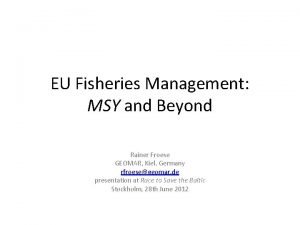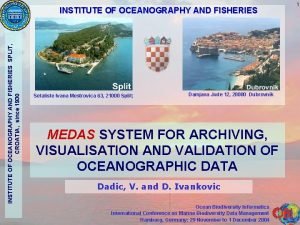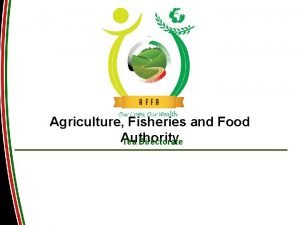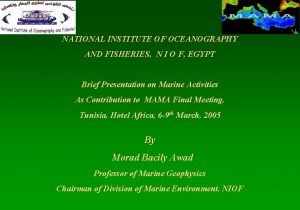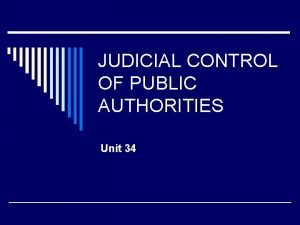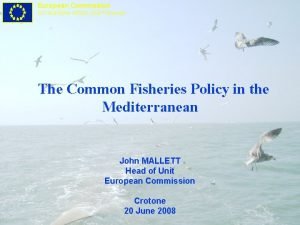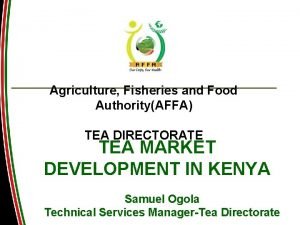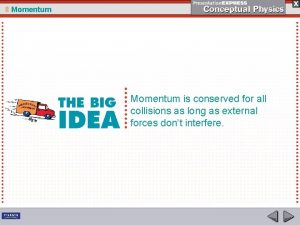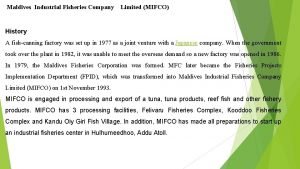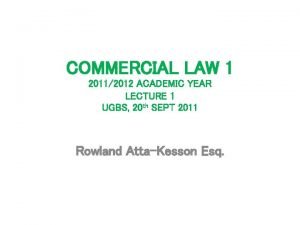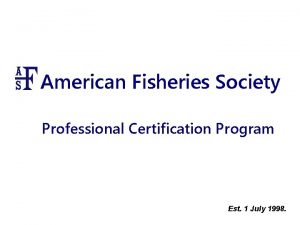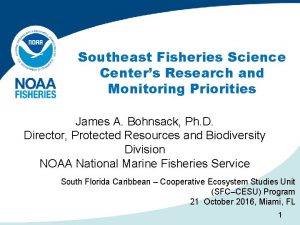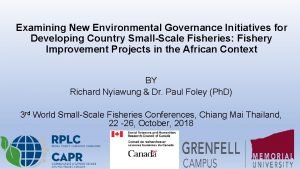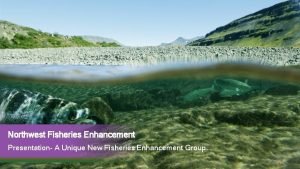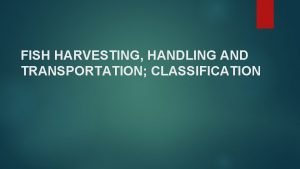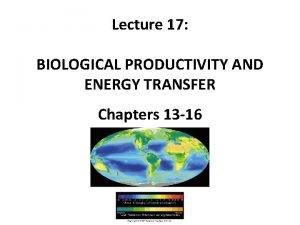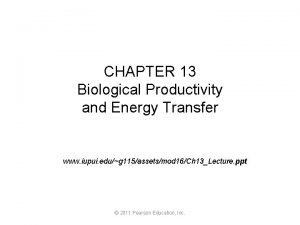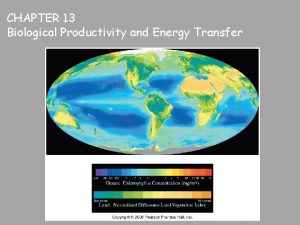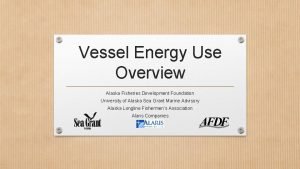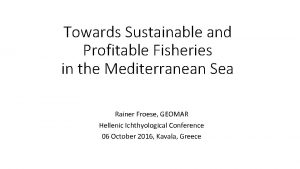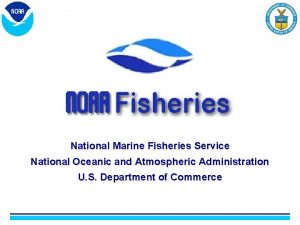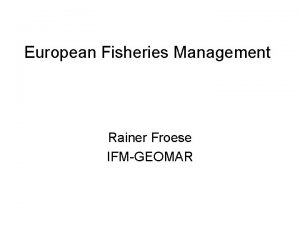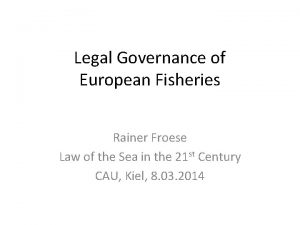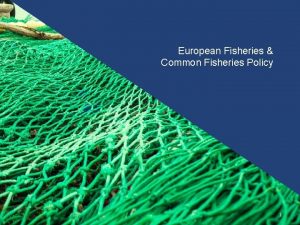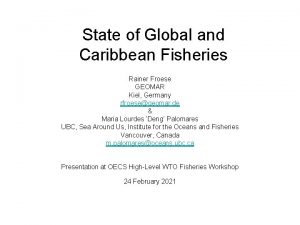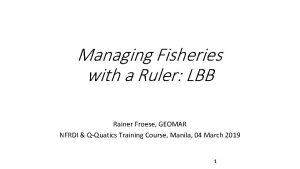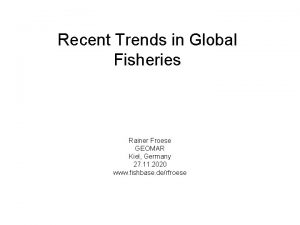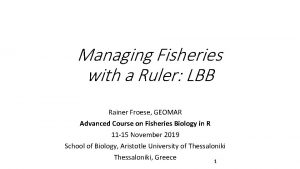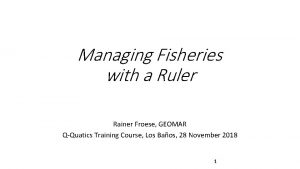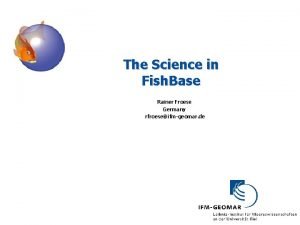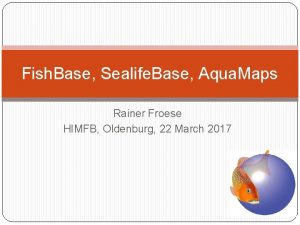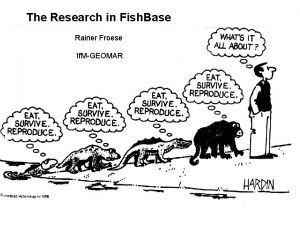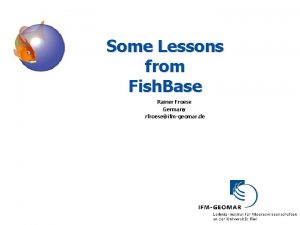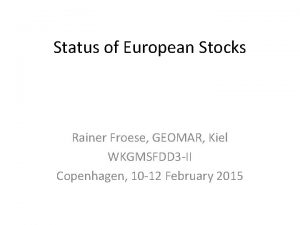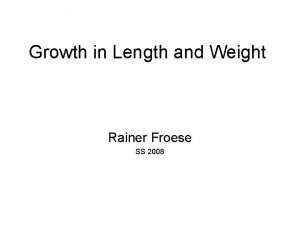Fish and Fisheries in European Seas Rainer Froese


























- Slides: 26

Fish and Fisheries in European Seas Rainer Froese, GEOMAR YOUMARES 7, Hamburg University 13 September 2016, Hamburg, Germany

Overview • Relevant European legislation • Crash course in fisheries management • Status of European stocks • Three rules to minimize the impact of fishing • Pitfalls of the MSY concept • Conclusions

Marine Strategy Framework Directive (MSFD, 2008) • D 3. 1 Keep fishing pressure below the maximum sustainable level • D 3. 2 Keep stock size above the level that can produce maximum sustainable catches, at least above the level of reduced reproduction • D 3. 3 Ensure age and size structure indicative of a healthy stock

Common Fisheries Policy (CFP, 2013) • All fish stocks have to be rebuilt above the level that can produce maximum sustainable yields (MSY) • Until 2015, fishing pressure has to be reduced to a level that allows the recovery of the stocks • Additional measures such as protected areas are to be established to protect juvenile fish 4

The new CFP Article 2. 2 • The CFP shall apply the precautionary approach to fisheries management, and shall aim to ensure that exploitation of living marine biological resources restores and maintains populations of harvested species above levels which can produce the maximum sustainable yield.

CFP and the Ecosystem Approach Preamble of CFP Whereas: . . . • (11) The CFP should contribute to the protection of the marine environment, to the sustainable management of all commercially exploited species, and in particular to the achievement of good environmental status by 2020, as set out in Article 1(1) of Directive 2008/56/EC of the European Parliament and of the Council 1. • (13) An ecosystem-based approach to fisheries management needs to be implemented, environmental impacts of fishing activities should be limited and unwanted catches should be avoided and reduced as far as possible.

CFP and the Ecosystem Approach • Article 4. 1 (9) 'ecosystem-based approach to fisheries management' means an integrated approach to managing fisheries within ecologically meaningful boundaries which seeks to manage the use of natural resources, taking account of fishing and other human activities, while preserving both the biological wealth and the biological processes necessary to safeguard the composition, structure and functioning of the habitats of the ecosystem affected, by taking into account the knowledge and uncertainties regarding biotic, abiotic and human components of ecosystems; Article 4. 1 (11) 'low impact fishing' means utilising selective fishing techniques which have a low detrimental impact on marine ecosystems or which may result in low fuel emissions, or both;

Article 8, Establishment of fish stock recovery areas 1. The Union shall, while taking due account of existing conservation areas, endeavour to establish protected areas due to their biological sensitivity, including areas where there is clear evidence of heavy concentrations of fish below minimum conservation reference size and of spawning grounds. In such areas fishing activities may be restricted or prohibited in order to contribute to the conservation of living aquatic resources and marine ecosystems.

CFP and Minimizing Impact of Fishing • Article 2. 3 The CFP shall implement the ecosystem-based approach to fisheries management so as to ensure that negative impacts of fishing activities on the marine ecosystem are minimised, and shall endeavour to ensure that aquaculture and fisheries activities avoid the degradation of the marine environment.

• Article 4. 1 (17) 'minimum conservation reference size' means the size of a living marine aquatic species taking into account maturity, as established by Union law, below which restrictions or incentives apply that aim to avoid capture through fishing activity; such size replaces, where relevant, the minimum landing size;

Quick & Dirty Definitions • MSY is the maximum catch that a stock can support; taking more will shrink the stock and will shrink future catches • Bmsy is the smallest biomass (stock size) that can support MSY • F is the proportion of fish in the water (on average over the year) that are killed by the fishery • Fmsy is the maximum F that is compatible with the MSY concept; Fmsy will lead to MSY and Bmsy, albeit very slowly • Bmey is the biomass with maximum profit for the fishers • Bpa is the biomass below which reproduction may be compromised

The MSY Framework

The MSY Framework CFP 2013 High biomass High profit High catch Overfishing Recovering Outside safe biological limits

Northeast Atlantic Stocks in 2013 Council Decision on TAC ► ◄ F & Reproduction & Growth ► ◄ Analysis of 47 stocks of the Northeast Atlantic with a Bayesian state-space production model, Froese et al. , submitted

Three Simple Rules Excerpts from a paper in Fish&Fisheries • Three simple rules for EBFM – Take less than nature ( F < M ) – Keep populations above half natural size (B > 0. 5 B 0) – Minimize impact of catch (Lmean = Lopt) • Such fishing shall result in – Large stocks & large fish & healthy ecosystems – High catches & low cost & good profits Froese et al. 2016 Minimizing the impact of fishing

Catch as a Function of Fishing Pressure (F/M) Yield relative to maximum possible yield per recruit, as a function of the F/M ratio and different lengths at first capture. The bold curve indicates optimum size selection, the lowest curve indicates no size selection. Froese et al. 2016

Stock Size Larger than Half of Unexploited • Ecosystem roles of stocks as prey and predator may be endangered if the stock is too small • Highest longterm yield is obtained at about half of unexploited stock size • But highest profits are obtained at about 20% larger stock sizes (default rule in Australia)

Biomass as a Function of F/M Biomass relative to unexploited biomass, as a function of the F/M ratio and different lengths at first capture. The bold curve indicates optimum size selection, the dot-dashed curve indicates no size selection. Froese et al. 2016

Maximizing Profits of Fishers • Profit of fishers is the difference between the value of the catch and the cost of fishing • Cost of fishing is a function of the abundance of fish • Highest profits are obtained at about 1. 2 Bmsy • 1. 2 Bmsy is therefore the target biomass level in Australia

Catch and Profit as a Function of F/M EC- Fisheries Relative yield and value as a function of fishing pressure. F/M < 0. 83 results in B > 0. 5 B 0. Froese et al. 2016

Size Matters: Let fish Grow and Spawn • Lopt is the mean length of parents in the absence of exploitation • For a given catch, fewer fish have to be killed if mean length in catch equals Lopt • For a given fishing pressure, highest catch is obtained if mean length in catch equals Lopt

Impact of Fishing on Size Structure The bold curve indicates no fishing. The three other curves indicate fishing with F=M, but with fishing starting at different lengths. Life history data of North Sea cod. Long-term catches are highest for Lc_opt

MSY Pitfalls & Failures Using MSY or Fmsy for all stocks • Forage fish such as anchovy, sprat, herring or sardines are the crucial link between lower and upper trophic levels in the food web • Forage fish transport energy from copepods to cods • Forage fish must therefore be fished less, e. g. with 0. 5 MSY or 0. 5 Fmsy • Forage fish typically have the lowest ex-vessel price and are mostly used for animal feed; it makes more economic sense to direct fisheries towards human consumption

Main Pitfall: • The Ministers of Agriculture (Council), in charge of fisheries, are blocking the implementation of the CFP • Overfishing continued in many stocks in 2015 and 2016 and is likely to also continue in 2017

Summary • The CFP sets the correct goal of rebuilding stocks above levels that can produce MSY • Above Bmsy is the area where high catches are obtained from large stocks at low cost of fishing • Above Bmsy can only be achieved if F < Fmsy • Forage fish must be fished less to maintain crucial ecosystem functions • To minimize the impact of fishing, minimum conservation reference size must be set such that fish can grow and reproduce before capture • The system has to be forced to implement its own laws

Thank You
 Rainer froese
Rainer froese One fish two fish red fish blue fish ride
One fish two fish red fish blue fish ride Tamara froese
Tamara froese One fish two fish blowfish blue fish script
One fish two fish blowfish blue fish script Scale types fish
Scale types fish сплит institute of oceanography and fisheries
сплит institute of oceanography and fisheries Agriculture fisheries and food authority
Agriculture fisheries and food authority Institute of oceanography and fisheries
Institute of oceanography and fisheries Ministry of food agriculture and fisheries denmark
Ministry of food agriculture and fisheries denmark Rules of natural justice
Rules of natural justice Dg maritime affairs and fisheries
Dg maritime affairs and fisheries Agriculture fisheries and food authority
Agriculture fisheries and food authority A big fish swims up and swallows a small fish at rest
A big fish swims up and swallows a small fish at rest Felivaru fisheries complex
Felivaru fisheries complex Non est factum example
Non est factum example Certified fisheries professional
Certified fisheries professional Southeast fisheries science center
Southeast fisheries science center Small-scale fisheries
Small-scale fisheries Northwest fisheries
Northwest fisheries Classification of fisheries
Classification of fisheries Ocean fisheries
Ocean fisheries Pearson prentice hall
Pearson prentice hall Biological productivity examples
Biological productivity examples Alaska fisheries development foundation
Alaska fisheries development foundation General fisheries commission for the mediterranean
General fisheries commission for the mediterranean National fisheries service
National fisheries service Boat security system
Boat security system
